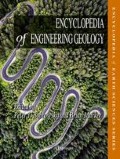Synonyms
Glaciomarine sediment; Leda clay; Sensitive clay
Definition
Quick clay is a special type of clay prone to sudden strength loss upon disturbance. From a relatively stiff material in the undisturbed condition, an imposed stress can turn such clay into a liquid slurry.
Discussion
Quick clay is defined as a clay where the undisturbed shear strength of the soil is at least 30 times greater than the remoulded (or disturbed) shear strength (Torrance 1983). The ratio of undisturbed to disturbed strength is termed sensitivity. Thus a quick clay is very sensitive.
Quick clay is common along previously glaciated coastlines in parts of Canada and Scandinavia, and has also been found in Japan and in Alaska. Coastlines in these areas were submerged by the weight of glaciers during glaciation. As glaciers retreated, seas migrated inland with retreating icefronts. Glacially ground sediments, transported in plumes of glacial meltwater were deposited in the salt water of these ice marginal seas.
In freshwater, clay particles settle more slowly and separate from the larger silt particles. In salt water, clay and silt flocculate and settle together with a random orientation. Negative, repulsive charges on the clay particles are neutralized by Na+ and Ca2+ in sea water. The resulting sediment has an open structure with high water content. The positive charges of the salts maintain the interparticle bonds that allow the open structure to persist.
As the glaciers disappeared the land began to rebound isostatically, rising as much as 300 m above present-day sea level in the Hudson Bay area of Canada. Exposure of the uplifted glaciomarine sediments to rainfall and groundwater leached salt from the porewater. Salt content would decrease from initial concentrations as high as thirty grams per liter in the sea to less than 1 g per liter. With reduced salt content repulsive forces between particles increased, leaving the saturated, porous sediment prone to collapse. Given the right conditions, sediments that underwent this process could become quick clay.
An imposed load, vibration, or bank erosion, can collapse the sedimentary structure in sensitive clay, often causing liquefaction. During liquefaction, the weight of the soil is transferred from the solids to the porewater.
Sensitive and quick clay are hazardous because they can host sudden rapid landslides on extremely low gradients. On 29 April 1978, a destructive landslide occurred near the town of Rissa, Norway (Gregersen 1981). The largest landslide of the century in Norway, it covered 33 ha, involved 5–6 million m3 of quick clay and caused a displacement wave. The landslide was triggered by a small external load; Earth fill from the excavation of a barn. Seven farms and five houses were destroyed.
On 4 May 1971, 7 million m3 of quick clay at Saint Jean Vianney, Quebec, Canada, suddenly began to flow at a rate of more than 25 km/h into the Rivière du Petit-Bras carrying with it some 40 homes (Tavenas et al. 1971). The crater left by the landslide was 32 ha in area and up to 30 m deep.
References
Gregersen, O (1981) The quick clay landslide in Rissa, Norway. NGI Publication 135:1–6
Tavenas F, Chagnon J-Y, La Rochelle P (1971) The Saint-Jean-Vianney landslide: observations and eyewitnesses accounts. Can Geotech J 8:463–478
Torrance JK (1983) Towards a general model of quick clay development. Sedimentology 30:547–555
Author information
Authors and Affiliations
Corresponding author
Editor information
Editors and Affiliations
Rights and permissions
Copyright information
© 2018 Her Majesty the Queen in Right of Canada
About this entry
Cite this entry
Geertsema, M. (2018). Quick Clay. In: Bobrowsky, P.T., Marker, B. (eds) Encyclopedia of Engineering Geology. Encyclopedia of Earth Sciences Series. Springer, Cham. https://doi.org/10.1007/978-3-319-73568-9_231
Download citation
DOI: https://doi.org/10.1007/978-3-319-73568-9_231
Published:
Publisher Name: Springer, Cham
Print ISBN: 978-3-319-73566-5
Online ISBN: 978-3-319-73568-9
eBook Packages: Earth and Environmental ScienceReference Module Physical and Materials ScienceReference Module Earth and Environmental Sciences

